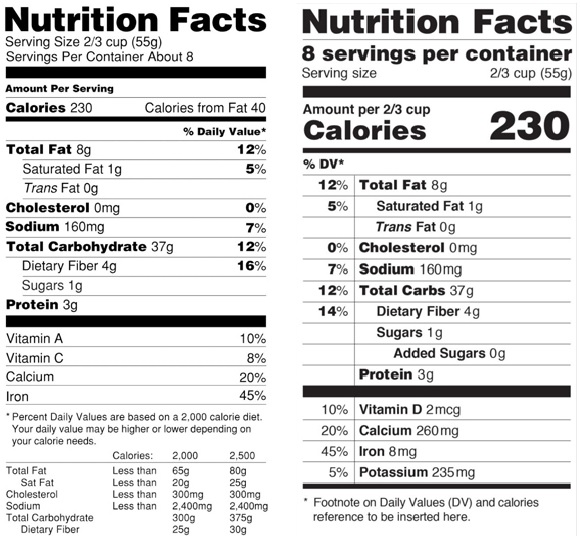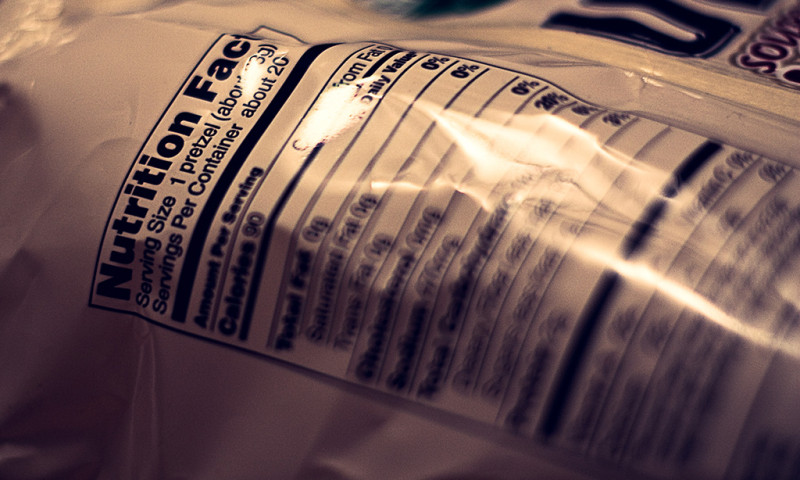Photo credit: Dan Domme via Visual Hunt / CC BY-NC-ND
Things are changing for nutrition fact labels, and in a good way for consumers! The Food and Drug Administration (FDA) is proposing an update to the nutrition facts label found on the foods you eat every day, and these labels can be your ticket to good health. This can be achieved by providing us with needed information, like the content of carbohydrates, fat and sodium in the foods we are choosing, to name a few.
Food labels make it easy for consumers to make choices based on the information they receive on the label, and they give you a true picture of the food you are eating. When the label is used correctly, it can guide people to choose the right foods to improve their health.
Labels work well as long as you understand them. Many times, consumers can be overwhelmed and confused when reading food labels. Consumers report that they look for things like fat, sugar and carbohydrates. When they are asked how much of each they aim for, there is much confusion. People know what to look for, but are sometimes unsure of the targets. With the proposed changes to the current food labels, consumers will have an easier time finding the nutritional information they are looking for.
The History of Nutrition Fact Labels
Food labeling has not been around forever. The Nutrition Labeling and Education Act (NLEA) came about in 1990 and gave the FDA the authority to require nutrition labeling on foods. In 1994, this rule became effective, and with the addition of this powerful tool, health conscious Americans know what really is in the foods they eat every day.
The only additional change to these labels since 1994 has been the addition of listing trans-fat in 2008. In 2014, the FDA released a proposed revamp to the food label and asked for comments. They have received plenty, with nutrition professionals from all over giving their recommendations for the new label. Public commenting is now closed, and we are waiting for the final version to arrive. Once this information is released, manufacturers will have two years to put the guidelines in place.
Below are some of the proposed changes. Many of the changes will provide more clear information for consumers. By making the label user-friendly, it will be easier to make good choices that will impact long-term health.
What’s New on the Nutrition Fact Labels?

1. Serving Size
Out with the old:
Have you ever eaten a bag of crackers or cookies and then looked at the label and realized you just ate two or three servings? This happens all the time and can be a big problem that compounds today’s obesity epidemic. An individual bottle of juice, which looks like a single serving, is sometimes 2-3 servings or an individual package of crackers may actually contain two servings.
Serving sizes listed on packages sometimes fall short of what people actually eat. Eating a “normal serving” of ice cream is sometimes three times the serving listed on the package. If people don’t realize this, they can pack in more calories, sugar and fat than they thought they would.
In with the new:
With the new label, the serving size and servings per bag will be closer to what Americans actually eat. Realistic serving sizes will help Americans gauge what they are eating. This will cut down on the confusion for sure, and people can get a more accurate picture. Also, items that are packaged as a single serving will be marked as a single serving. A bottle of juice or individual package of crackers will be labeled as one, not two servings.
2. Calories
Out with the old:
In the current label, calories are the same font size as every other item on the label. This is fine, but it is easy to glaze over them when scanning the label.
In with the new:
Notice the font. It’s bigger! Everyone needs to have a ball park idea of how many calories they need each day. This helps by making it big, really big. If you have a general idea and can see the amount listed in bold letters, you can decide if it fits into your calorie budget.
3. Calories from Fat
Out with the old:
On the first version, the label listed how much and how many of the total calories came from fat. This was another guide to give consumers an idea of how much fat they were taking in every day. It was often confusing for people because many consumers focus on total fat grams.
In with the new:
In the updated label, calories from fat have been deleted. Why? The newer emphasis is on types of fat instead of total fat. We now know, all fats aren’t created equal. Instead of looking at calories from fat, the focus is the type of fat. Limiting saturated fat and trans fat is far more important.
4. Added Sugars
Out with the old:
With the first label, there was not such a big emphasis on sugar. We have learned throughout the years that sugar is something we need to be aware of and monitor closely. With the current label, you can see how much total sugar is in the product, but you don’t really know where that sugar comes from. For example, sugars from milk or an apple could look the same as sugars from a cookie on the current version. We know this is not the case, and this can be quite confusing. It is easy to think skim milk or light yogurt has too much sugar, when in reality, this sugar comes naturally from lactose.
In with the new:
With the new label, added sugars are listed directly on the label. This gives consumers a chance to see how much sugar is added to a product vs. what occurs naturally. For example, applesauce would contain sugar (fructose, which is naturally occurring), but now you can see if there was any sugar added to the product.
5. Essential Nutrients
Out with the old:
Vitamin A, vitamin C, iron and potassium are listed, along with their percent daily value. This means if you are eating a 2,000 calorie diet, the current label lists what percent you are taking in of your total needs per day. This is nice information, but doesn’t mean a lot for those of us who don’t eat a 2,000 calorie diet.
In with the new:
There are changes in the nutrients listed. The focus is now on vitamin D, iron, calcium and potassium. We still see the information on percent daily value, but we also see how much of each nutrient is in the product per serving. This is helpful if you are monitoring your intake, and can be a great way for you to keep tabs on these nutrients.
Conclusion
The nutrition fact label is such an important tool, but as with any tool, it only works if you use it. It is the hope that with this revised nutrition fact label, consumers will be able to easily decipher it, make good choices and improve their overall health. Small changes to an individual’s diet can make a big impact on their health. There are many tools available to the public to improve their health and well-being, and as resources are improved, revamped and become more user-friendly, the public has the most up-to-date information to live a healthier lifestyle.
About the Author:
Sarah Muntel, RD, is the Bariatric Coordinator at Community Bariatric Surgeons in Indianapolis, IN. She has 15 years of experience working with bariatric patients and loves to work with people as they change their lives and improve their health. Her favorite part of her job is her weekly support group. In her free time, Sarah enjoys spending time with her husband and three children.
This article originally appeared in the Winter 2016 issue of Your Weight Matters Magazine. To learn more about Your Weight Matters Magazine and request a free copy of this educational resource today, CLICK HERE.






